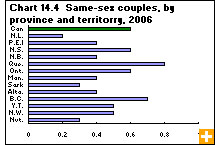Common menu bar links
More same-sex couples being counted
Archived Content
Information identified as archived is provided for reference, research or recordkeeping purposes. It is not subject to the Government of Canada Web Standards and has not been altered or updated since it was archived. Please contact us to request a format other than those available.
Following the legalization of same-sex marriage in Canada in July 2005, the 2006 Census enumerated same-sex married couples for the first time. The census counted 45,300 same-sex couples, making up 0.6% of all couples in Canada. Among that 45,300, 17% were same-sex married couples.
Although still few, the number of same-sex couples has increased five times faster than the number of opposite-sex couples. From 2001 to 2006, the number of same-sex couples grew 33%, whereas the number of opposite-sex couples grew 6%.
Quebec has Canada’s largest proportion of same-sex couples: 0.8% of all couples in 2006. Half of all same-sex couples lived in the three major census metropolitan areas of Toronto, Montréal and Vancouver.
In 2006, 54% of same-sex married spouses were men; 46% were women. Proportions were similar for same-sex common-law partners in both 2006 and 2001.
About 9% of individuals in same-sex couples had children aged 24 and under living at home in 2006. Children at home were more common for women in same-sex couples than for men. Also, same-sex married spouses were more likely to have children at home than were same-sex common-law partners.
People in same-sex couples were generally younger than their counterparts in opposite-sex couples: 25% of people in same-sex couples were aged 34 and younger, and 4% were seniors 65 or older. In opposite-sex couples, 18% were aged 34 and under, and 16% were seniors.



